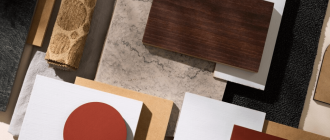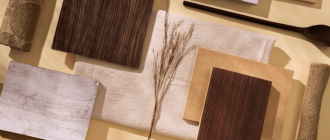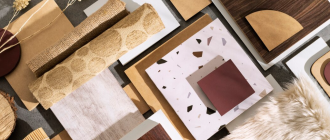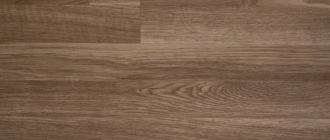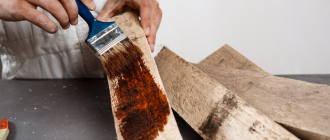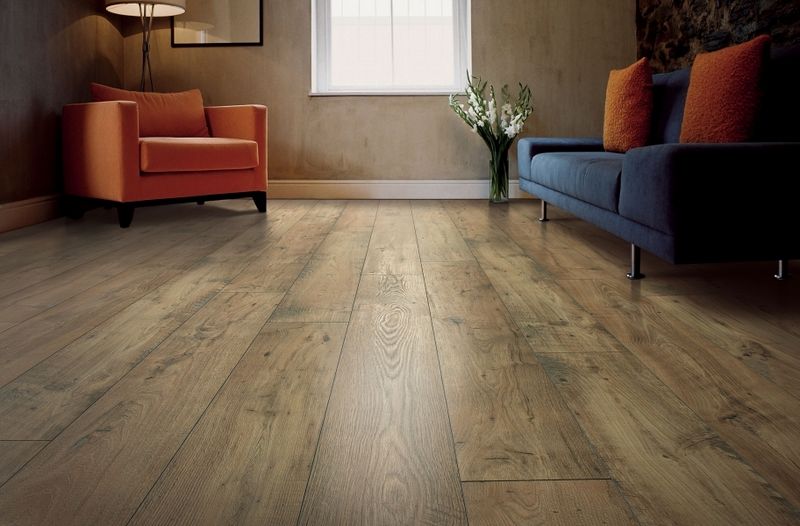
5 Myths About Laminate Flooring
Laminate flooring has become a popular choice for homeowners looking to give their space a stylish and durable upgrade. However, there are still many misconceptions surrounding this type of flooring. In this article, we will debunk five common myths about laminate flooring.
Myth #1: Laminate flooring is not as durable as hardwood or tile.
Contrary to popular belief, laminate flooring is actually quite durable. It is constructed with multiple layers that are fused together, making it resistant to scratches, stains, and dents. Additionally, many laminate flooring options come with a protective coating that adds to its durability and longevity.
Myth #2: Laminate flooring looks cheap and artificial.
While it’s true that some older laminate flooring options may have had a more artificial appearance, modern laminate flooring has come a long way. Manufacturers now use advanced printing techniques to create realistic-looking wood, stone, and tile designs. With a wide range of options available, you can easily find a laminate flooring design that suits your aesthetic preferences.
Myth #3: Laminate flooring is difficult to install.
Thanks to advancements in technology, laminate flooring is now easier to install than ever before. Many laminate flooring options come with a click-lock system, allowing for a simple and quick installation process. Additionally, some manufacturers offer installation kits and instructions that make the process even more user-friendly.
Myth #4: Laminate flooring is not suitable for moisture-prone areas.
While it’s true that excessive moisture can damage laminate flooring, many manufacturers now offer waterproof or water-resistant options. These special laminates are designed to withstand moisture and can be installed in bathrooms, kitchens, and other areas prone to spills and humidity.
Myth #5: Laminate flooring is difficult to clean and maintain.
Contrary to popular belief, laminate flooring is actually quite easy to clean and maintain. Regular sweeping and occasional mopping with a damp cloth or mop is usually all that’s needed to keep your laminate flooring looking its best. Additionally, many laminate flooring options come with stain-resistant technology, making it easier to clean up spills and stains.
Now that we have debunked these common myths, it’s clear that laminate flooring is a great choice for homeowners looking for a stylish, durable, and low-maintenance flooring option. With its wide range of designs and affordable price point, laminate flooring continues to be a popular choice for both residential and commercial spaces.
Laminate Flooring is Cheap and Low Quality
There is a common misconception that laminate flooring is cheap and low quality. However, this is not necessarily true. Laminate flooring can be a budget-friendly option, but that doesn’t mean it lacks quality. In fact, laminate flooring has come a long way in recent years and can now rival the look and durability of more expensive flooring options.
Here are five myths about laminate flooring:
- Laminate flooring is made of cheap materials.
-
Laminate flooring looks fake.
-
Laminate flooring is difficult to install.
-
Laminate flooring is not durable.
-
Laminate flooring is only suitable for low-traffic areas.
This is not the case. While laminate flooring is typically made of layers of melamine resin and fiberboard, these materials have been designed to be durable and long-lasting. Many laminate options are also resistant to scratches, stains, and fading, making them a practical choice for high-traffic areas.
While it’s true that laminate flooring is made to mimic the look of other materials like hardwood or stone, advancements in technology have made the patterns and textures more realistic than ever before. Nowadays, you can find laminate flooring that closely resembles the natural beauty and character of real hardwood or stone.
On the contrary, laminate flooring is known for its easy installation process. Many laminate options feature a click-lock system, which allows the planks to easily snap together. This means you can save time and money on professional installation and take on the project yourself.
While laminate flooring may not be as durable as hardwood or tile, it is still a resilient choice for most homes. The hard, wear-resistant surface layer helps protect against scratches, spills, and other everyday wear and tear. Additionally, laminate flooring is often backed by warranties, giving you peace of mind that it will stand the test of time.
While laminate flooring can certainly be used in low-traffic areas, it is also suitable for high-traffic areas in your home. With its scratch and stain resistance, laminate flooring can withstand the wear and tear of busy households, making it a practical option for spaces like the kitchen, entryways, and living rooms.
So, if you’re looking for a cost-effective and durable flooring option, don’t overlook laminate flooring. With its realistic look, easy installation, and resistance to everyday wear and tear, laminate flooring can be a smart choice for any home.
Laminate Flooring is Difficult to Install
One of the common myths about laminate flooring is that it is difficult to install. However, this is not true. Laminate flooring is actually one of the easiest types of flooring to install, making it a popular choice for DIY enthusiasts.
Here are a few reasons why installing laminate flooring is not as difficult as it may seem:
- Click-and-lock system: Laminate flooring typically comes with a click-and-lock system, which makes the installation process straightforward. The planks simply snap together, creating a secure and seamless connection.
- No need for extensive subfloor prep: Unlike other types of flooring, such as hardwood or tile, laminate flooring can be installed over existing floors, including concrete, plywood, or even existing laminate. This eliminates the need for extensive subfloor preparation.
- Minimal tools required: Installing laminate flooring only requires a few basic tools, such as a tape measure, utility knife, and a saw for cutting the planks. These tools are easily accessible and affordable, making the installation process more convenient.
- Clear installation instructions: Most laminate flooring manufacturers provide clear and detailed installation instructions with their products. These instructions typically include step-by-step guides, diagrams, and even video tutorials, making it easier for homeowners to install the flooring themselves.
While laminate flooring may seem intimidating to some, it is important to debunk the myth that it is difficult to install. With the right tools, materials, and instructions, installing laminate flooring can be a manageable and rewarding DIY project.
Laminate Flooring is Not Durable
One of the common myths surrounding laminate flooring is that it is not durable. This misconception likely stems from the fact that laminate flooring is made from layers of synthetic materials, rather than solid wood like traditional hardwood flooring.
However, laminate flooring is actually quite durable and designed to withstand everyday wear and tear. The top layer of laminate flooring is a tough, transparent wear layer that protects the surface from scratches, stains, and fading. This wear layer is typically made from an aluminum oxide coating or melamine resin, making it highly resistant to damage.
Laminate flooring is also known for its excellent resistance to moisture, making it a popular choice for kitchens, bathrooms, and other areas prone to spills and moisture. The core layer of laminate flooring is made from high-density fiberboard (HDF) or particle board, which provides stability and strength to the flooring.
While laminate flooring is not completely impervious to damage, it is much more durable than many people believe. With proper care and maintenance, laminate flooring can last for many years without showing signs of wear or damage.
It is important to note that laminate flooring is not suitable for all situations. It is not recommended for areas with excessive moisture or humidity, such as basements or laundry rooms. In these cases, other types of flooring, such as vinyl or tile, may be a better choice.
In conclusion, the myth that laminate flooring is not durable is simply not true. Laminate flooring is designed to be durable, resistant to wear, and easy to maintain. It is a cost-effective option that provides the look of hardwood without the high price tag. So, if you’re looking for a durable and affordable flooring option, don’t overlook laminate!
Laminate Flooring Looks Fake and Unattractive
One of the most common myths about laminate flooring is that it looks fake and unattractive. While it’s true that laminate flooring is not made of real wood, it has come a long way in terms of its appearance and can now closely resemble the look of authentic hardwood.
Manufacturers use advanced printing technologies to create a wide range of designs and textures that mimic the natural beauty of wood. From oak and maple to hickory and walnut, there is a laminate flooring option to suit any aesthetic preference.
Additionally, laminate flooring often features embossed textures, which further enhances its realistic appearance. These textures replicate the feel of real wood grain, adding depth and character to the flooring.
Moreover, laminate flooring is available in various colors and finishes, allowing homeowners to customize their space according to their style and preferences. Whether you prefer a dark, rich tone or a light, airy look, there is a laminate flooring option to complement your design scheme.
Furthermore, laminate flooring is an affordable alternative to hardwood flooring. It offers the same visual appeal at a fraction of the cost, making it a popular choice for budget-conscious homeowners.
Overall, while laminate flooring may not be made of natural wood, it is far from fake and unattractive. With its advanced printing technologies, realistic textures, and wide range of design options, laminate flooring can provide a beautiful and cost-effective flooring solution for any home.
Laminate Flooring is Not Suitable for Moist Areas
One of the common myths about laminate flooring is that it is not suitable for moist areas. While it is true that laminate flooring is not recommended for installation in areas with high moisture levels, such as bathrooms, it can still be a great choice for other areas of your home.
Laminate flooring is engineered to be resistant to moisture, but it is not completely waterproof. Excessive exposure to moisture can cause the boards to warp or swell, so it’s important to take precautions in areas where water is likely to be present.
However, laminate flooring can be a suitable option for areas with occasional moisture, such as kitchens or laundry rooms, as long as proper care is taken. This includes promptly wiping up spills, using mats or rugs in high-traffic areas, and avoiding excessive water exposure.
There are also laminate flooring options available that are specifically designed to be more water-resistant, such as waterproof laminate flooring. These types of laminate flooring have a special waterproof backing that helps protect the boards from moisture damage. However, it is still important to follow proper maintenance and care guidelines to ensure the longevity of your laminate flooring.
In conclusion, while it is true that laminate flooring is not recommended for installation in moist areas, it can still be a suitable choice for other areas of your home. By taking proper care and following maintenance guidelines, you can enjoy the beauty and durability of laminate flooring in various areas of your home.
Laminate Flooring is Hard to Clean and Maintain
One of the common myths about laminate flooring is that it is hard to clean and maintain. However, this is not true. Laminate flooring is actually quite easy to clean and requires minimal maintenance compared to other types of flooring.
With laminate flooring, you don’t have to worry about grout lines or stains like you would with tile or carpet. The smooth surface of laminate flooring makes it easy to clean up spills and dirt with a simple sweep, mop, or vacuum. Unlike hardwood floors, laminate flooring doesn’t require regular waxing or polishing to maintain its shine.
To keep your laminate flooring looking its best, it is recommended to sweep or vacuum it regularly to remove any dirt or debris. For deeper cleaning, you can use a damp mop with a mild floor cleaner specifically designed for laminate floors. It’s important to avoid using excessive water, as moisture can damage the laminate planks.
Another advantage of laminate flooring is that it is resistant to stains and scratches. The top layer of laminate is made with a protective coating that helps to prevent stains and scratches from penetrating the surface. However, it is still important to clean up any spills or stains as soon as possible to prevent them from causing damage.
Overall, laminate flooring is a low-maintenance option that is easy to clean and maintain. By following simple cleaning and maintenance practices, you can keep your laminate floors looking beautiful for years to come.
Laminate Flooring is Noisy and Echoes
One of the most common myths about laminate flooring is that it is noisy and echoes. However, this is not true.
Laminate flooring is known for its durability and stability. It is made up of layers of wood materials that are fused together under high pressure and heat. This construction makes laminate flooring rigid and resistant to warping and bending.
As a result, laminate flooring does not produce excessive noise or echoes when walked on. In fact, many homeowners find that laminate flooring is quieter compared to other types of flooring, such as hardwood or tile.
To further reduce any potential noise, you can add an underlayment, which acts as a sound barrier and absorbs impact. This helps to muffle any sound and eliminates echoing.
It’s important to also note that the installation of laminate flooring plays a role in how noisy it may be. If the planks are not properly installed or if there are gaps between the planks, it can create a clicking or tapping sound. However, with proper installation, laminate flooring should not be noisy or create echoes.
In conclusion, the belief that laminate flooring is noisy and echoes is a myth. Laminate flooring is actually known for its quietness and stability, making it a great choice for any home.
Laminate Flooring is Prone to Scratches and Damage
One common misconception about laminate flooring is that it is easily scratched or damaged. However, this is not entirely true. While laminate flooring is not completely immune to scratches and damage, it is designed to be durable and resistant.
Laminate flooring is made up of several layers, including a wear layer that provides protection against scratches and stains. This wear layer is typically made of aluminum oxide, which is a hard substance that helps to prevent scratches from occurring.
Additionally, laminate flooring is designed to withstand normal wear and tear, making it ideal for high-traffic areas such as living rooms, hallways, and kitchens. It is also resistant to fading from sunlight exposure, unlike some types of hardwood flooring.
However, it is important to note that laminate flooring can still be damaged if not properly maintained. For example, dragging heavy furniture across the floor or using abrasive cleaners can cause scratches or dents. It is recommended to use furniture pads or felt protectors under heavy furniture to prevent damage.
Regular cleaning and maintenance of laminate flooring can help to keep it looking its best and prevent damage. This includes sweeping or vacuuming regularly to remove dirt and debris, and wiping up spills promptly to prevent staining.
In conclusion, while laminate flooring is not completely impervious to scratches and damage, it is designed to be durable and resistant. With proper care and maintenance, laminate flooring can remain in excellent condition for many years.
Laminate Flooring is Not Eco-Friendly
One of the common myths surrounding laminate flooring is that it is not eco-friendly. However, this is not entirely accurate. While it is true that some laminate flooring products may contain chemicals that can be harmful to the environment, not all laminate flooring falls under this category.
In fact, there are many eco-friendly options available in the market today. Manufacturers have started producing laminate flooring using sustainable materials and methods that have minimal impact on the environment. These eco-friendly laminate flooring products are made from recycled materials, such as wood fibers and plastics, and they are also designed to be recyclable at the end of their lifespan.
Another misconception is that laminate flooring requires the cutting down of trees to produce. While it is true that laminate flooring is made to resemble hardwood, it does not mean that the material used is from freshly cut trees. Laminate flooring is created using a high-pressure process that layers materials together. The topmost layer is a realistic photographic image of wood, while the core layers are made from recycled wood fibers and resin. This means that laminate flooring is actually an excellent alternative to hardwood flooring, as it reduces the demand for harvesting new trees.
In addition, laminate flooring is known for its durability and longevity. Unlike some other flooring options, such as carpet or vinyl, laminate flooring can last for many years without needing to be replaced. This means that less waste is generated over time, as there is no need for frequent replacements.
Furthermore, laminate flooring is easy to clean and maintain. It does not require the use of harsh chemical cleaners, and simple sweeping and occasional mopping are usually sufficient to keep it looking clean and fresh. This helps to minimize the impact on the environment by reducing the use of harmful cleaning products.
In conclusion, the myth that laminate flooring is not eco-friendly is based on misinformation. In reality, there are many eco-friendly options available in the market today. From using sustainable materials to being recyclable, laminate flooring can be a responsible choice for those looking for an environmentally friendly flooring option.
Laminate Flooring Does Not Add Value to a Home
One common myth about laminate flooring is that it does not add value to a home. However, this is not true. Laminate flooring can actually enhance the value of a property in several ways.
- Affordability: One of the main advantages of laminate flooring is its affordability. Compared to other types of flooring, such as hardwood or stone, laminate flooring is generally more cost-effective. This makes it an attractive option for potential homebuyers who are looking for a visually appealing yet budget-friendly flooring solution.
- Durability: Contrary to the misconception that laminate flooring is not durable, it is actually quite resistant to scratches, stains, and fading. Laminate flooring is made using multiple layers that are fused together under high pressure, resulting in a strong and durable surface. This durability can be seen as a valuable feature for homebuyers, as it ensures that the flooring will stand up to everyday wear and tear.
- Easy Maintenance: Another benefit of laminate flooring is its ease of maintenance. Unlike some other types of flooring, laminate does not require special cleaning products or extensive maintenance routines. Regular sweeping and occasional mopping are usually sufficient to keep the surface clean and in good condition. This low-maintenance aspect can be seen as an attractive feature for potential homebuyers, as it saves both time and money in the long run.
- Variety of Styles and Designs: Laminate flooring offers a wide range of styles and designs to choose from. Whether someone prefers the look of hardwood, tile, or stone, there is a laminate option available to suit their preferences. This versatility allows homeowners to personalize their living spaces and can be seen as a valuable feature when selling a property.
- Resale Value: Finally, it is important to note that laminate flooring can positively impact the resale value of a home. Many homebuyers are looking for a move-in ready property, and laminate flooring can enhance the overall appeal of the space. Additionally, if the laminate flooring is in good condition and well-maintained, it can contribute to a higher sale price by making the property more attractive to potential buyers.
Overall, the idea that laminate flooring does not add value to a home is a myth. In reality, laminate flooring can increase the attractiveness, functionality, and overall value of a property. This, coupled with its affordability and durability, makes laminate flooring a popular choice among homeowners and homebuyers alike.
Laminate Flooring is Limited in Design Options
One of the most common myths about laminate flooring is that it has limited design options. Many people believe that laminate flooring only comes in a few basic colors and patterns, and that it lacks the diversity and visual appeal of other flooring options. However, this is far from the truth.
In reality, laminate flooring offers a wide range of design options that can suit any style or aesthetic preference. With advancements in technology, laminate flooring manufacturers are able to replicate the look of various natural materials, such as hardwood, stone, and tile. This means that you can enjoy the beauty and elegance of these materials without the high price tag and maintenance requirements.
Additionally, laminate flooring is available in a multitude of colors, patterns, and textures. Whether you prefer a rustic oak look, a sleek marble design, or a bold geometric pattern, there is a laminate flooring option for you. You can also choose from different plank sizes and installation patterns to create a unique and customized look for your space.
Furthermore, laminate flooring can be combined with other flooring materials to create visual interest and unique focal points. For example, you can use laminate flooring in a living room and combine it with carpet in the bedroom to create a contrasting yet cohesive design. The versatility of laminate flooring allows you to experiment with different combinations and create a personalized look.
In conclusion, the belief that laminate flooring is limited in design options is a myth. With its wide range of colors, patterns, textures, and the ability to replicate the look of natural materials, laminate flooring offers endless design possibilities. Whether you want to achieve a contemporary, traditional, or unique style, laminate flooring can help you bring your vision to life.
Laminate Flooring Cannot Be Refinished
One of the most common misconceptions about laminate flooring is that it cannot be refinished. However, this is not entirely true. While it is true that laminate flooring cannot be sanded down and refinished like solid hardwood flooring, there are some refinishing options available for laminate.
When laminate flooring is installed, it comes with a protective layer known as the wear layer. This wear layer is designed to protect the flooring from scratches, stains, and fading. Over time, this wear layer can become worn down and may need to be refreshed.
One option for refinishing laminate flooring is to have a professional reapply a new wear layer to the surface. This process involves sanding down the existing wear layer and applying a new one. This can help restore the look of the floor and extend its lifespan.
Another option for refinishing laminate flooring is to use a laminate floor restoration product. These products are specifically designed to refresh the appearance of worn laminate flooring. They can help remove scratches, stains, and other signs of wear, giving the flooring a renewed look.
It is important to note that not all laminate flooring can be refinished, and it is always best to consult with a professional before attempting to refinish laminate flooring. Additionally, the refinishing options available may vary depending on the manufacturer and type of laminate flooring.
In conclusion, while it is true that laminate flooring cannot be refinished in the same way as solid hardwood flooring, there are options available to refresh the appearance and extend the lifespan of laminate flooring. It is important to understand the refinishing options available and consult with a professional to determine the best course of action for your specific laminate flooring.
Laminate Flooring is Slippery and Unsafe
One common misconception about laminate flooring is that it is slippery and unsafe. However, this is not entirely true. While it is true that laminate flooring can be slippery when wet, it is no more slippery than other hard flooring surfaces such as tile or hardwood.
In fact, many laminate flooring options now come with textured finishes or embossing that offer improved traction and reduce the risk of slipping. These textured finishes mimic the look and feel of real wood or stone, while providing a safer surface to walk on.
Additionally, there are many ways to make laminate flooring safer and less slippery. One option is to place rugs or mats in areas that are prone to getting wet, such as near entryways or in kitchens. These rugs or mats can provide an extra layer of traction and absorb moisture, reducing the chances of slipping.
Another option is to use anti-slip additives or treatments on the laminate flooring. These treatments can be applied to the surface of the laminate and provide additional grip, making it less slippery when wet.
Lastly, it’s important to remember that maintaining a safe and slip-free floor is not exclusive to laminate flooring. Proper maintenance and cleaning of any type of flooring is essential to ensure its safety. Regularly cleaning up spills, using appropriate cleaning products, and keeping floors dry can significantly reduce the risk of slipping and accidents.
In conclusion, while it is true that laminate flooring can be slippery when wet, it is not inherently unsafe. With the availability of textured finishes, the use of rugs or mats, and the application of anti-slip treatments, laminate flooring can be made safe and slip-resistant. By taking proper precautions and practicing good maintenance, laminate flooring can provide a beautiful and safe flooring option for any home or space.
Laminate Flooring Contains Harmful Chemicals
One common misconception about laminate flooring is that it contains harmful chemicals. However, this is not entirely true.
Laminate flooring is actually made from several layers of materials, including a photographic layer that mimics the look of real wood, stone, or tile. The core layer is typically made from high-density fiberboard (HDF) or medium-density fiberboard (MDF), which are engineered wood products.
While it’s true that some laminate flooring products may contain trace amounts of chemicals, such as formaldehyde, the levels are usually well below the limits set by regulatory agencies. In fact, formaldehyde emissions from laminate flooring have significantly decreased in recent years due to stricter regulations and improved manufacturing processes.
Furthermore, many laminate flooring manufacturers now offer low or zero VOC (volatile organic compounds) options, which means they have minimal or no harmful chemicals in their products. These options are particularly popular among eco-conscious consumers who prioritize indoor air quality.
It’s important to note that laminate flooring, like any other type of flooring, should be installed and maintained according to the manufacturer’s instructions to ensure optimal safety and performance. This includes proper ventilation during installation and routine cleaning to remove dust and dirt particles.
In conclusion, the myth that laminate flooring contains harmful chemicals is not entirely accurate. While there may be trace amounts of chemicals present, the levels are typically within safe limits, and many manufacturers now offer low or zero VOC options for those concerned about indoor air quality.
Laminate Flooring is Difficult to Remove and Replace
One of the common myths about laminate flooring is that it is difficult to remove and replace. However, this is not entirely true. While the process may require some effort and time, it is not as challenging as it may seem.
When it comes to removing laminate flooring, it is important to remember that it is a floating floor, which means it is not attached directly to the subfloor. This makes it easier to remove compared to other types of flooring. Additionally, laminate flooring is often installed using a click-lock system, which allows the planks to be easily unclicked and removed.
To begin the removal process, you will need to start at one end or corner of the room and carefully lift the edge of the laminate plank. Once the edge is lifted, you can continue to gently lift and pull on the plank until it is completely removed. It is important to be cautious during this process to avoid damaging the surrounding planks or the subfloor.
If you encounter any difficulty in removing certain planks, you can use a putty knife or a small pry bar to gently lift them. However, it is important to use these tools with caution to prevent any damage to the planks or the subfloor.
After removing the laminate flooring, you can proceed with the installation of the new flooring. Depending on the type of flooring you choose, the installation process may vary. However, most new flooring options can be easily installed using a similar click-lock system.
Overall, while removing and replacing laminate flooring may require some effort and time, it is not as difficult as it may seem. With the right tools and techniques, you can successfully remove and replace laminate flooring without much trouble.
Questions and answers:
Is laminate flooring more expensive than hardwood?
No, laminate flooring is generally less expensive than hardwood flooring. Laminate flooring is made from composite wood pressed together at high temperatures, while hardwood flooring is made from solid wood. The manufacturing process of laminate flooring allows for a lower cost per square foot compared to hardwood.
Is laminate flooring durable?
Yes, laminate flooring is known for its durability. It is designed to withstand everyday wear and tear, including scratches, dents, and fading. Laminate flooring is made with a protective layer that helps it resist moisture and stains, making it a good choice for high-traffic areas of the home.
Can laminate flooring be installed in wet areas like bathrooms?
No, it is not recommended to install laminate flooring in wet areas like bathrooms. While laminate flooring is generally water-resistant, it is not fully waterproof. Excessive exposure to moisture can cause the laminate to swell and warp over time. It is best to choose a different type of flooring, such as vinyl or tile, for wet areas.
Is laminate flooring difficult to clean?
No, laminate flooring is actually quite easy to clean. Regular sweeping or vacuuming to remove dirt and debris is usually sufficient. For deeper cleaning, a damp mop or cloth with a mild cleaning solution specifically designed for laminate floors can be used. It is important to avoid excessive moisture, as it can damage the laminate.
Does laminate flooring look cheap and fake?
No, modern laminate flooring is designed to mimic the look of real wood, stone, or tile. With advancements in technology, laminate flooring can have a realistic texture and appearance, making it difficult to distinguish from natural materials. There are many options available for laminate flooring that can suit different aesthetic preferences and design styles.
Is laminate flooring durable?
Yes, laminate flooring is quite durable. It is made with multiple layers of resin and fiberboard, which makes it resistant to scratches, stains, and dents.
Can laminate flooring be installed in all rooms?
Laminate flooring can be installed in most rooms of the house, except for areas with excessive moisture such as bathrooms and laundry rooms. It is best to consult the manufacturer’s recommendations to ensure proper installation.

